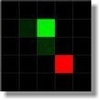
Localization microscopy software generally contains three elements: a localization algorithm to determine fluorophore positions on a specimen, a quality control method to exclude imprecise localizations, and a visualization technique to reconstruct an image of the specimen. Such algorithms may be designed for either sparse or partially overlapping (dense) fluorescence image data, and making a suitable choice of software depends on whether an experiment calls for simplicity and resolution (favouring sparse methods), or for rapid data acquisition and time resolution (requiring dense methods). We discuss the factors involved in this choice. We provide a full set of MATLAB routines as a guide to localization image processing, and demonstrate the usefulness of image simulations as a guide to the potential artefacts that can arise when processing.







